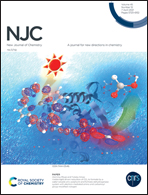Ultrasensitive Fe3+ ion detection based on pH-insensitive fluorescent graphene nanosensors in strong acid and neutral media†
Abstract
Sensitive and selective detection of iron ions is important for environmental monitoring and biological studies because iron ions play crucial roles in many physiological and pathological processes including cellular metabolism, enzymatic activities, oxygen transport, as well as DNA and RNA syntheses. In spite of intensive research, high-sensitivity fluorescent probes for the detection of iron ions in strong acid and neutral media are still lacking. In the present work, fluorescent graphene (FRGO) with stable blue fluorescence was synthesized by one-step heat treatment of reduced graphene oxide (RGO) with furfurylamine. Compared with previously reported carbon-based fluorescent materials, FRGO drastically improved the fluorescence stability in the pH range of 1–13 and surface chemical reactivities. FRGO could be used as an efficient fluorescent probe for the highly selective detection of Fe3+ in both strong acid and neutral media. The limits of detection of FRGO as a probe for detecting Fe3+ were as low as 0.01 nM and 0.02 nM in strong acid and neutral media, respectively, which were extremely sensitive to Fe3+. The fluorescence-quenching mechanism of FRGO caused by Fe3+ ions at pH = 1 was proposed to be determined by the IEF phenomenon, and the fluorescence quenching mechanism of FRGO caused by Fe3+ ions at pH = 7 was proposed to be a cooperative effect of the IEF and SQE. FRGO was also applied for the detection of trace Fe3+ in natural water samples.



 Please wait while we load your content...
Please wait while we load your content...